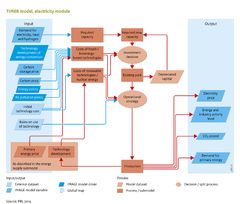Energy conversion/Description: Difference between revisions
Jump to navigation
Jump to search
No edit summary |
No edit summary |
||
| Line 1: | Line 1: | ||
{{ComponentDescriptionTemplate | {{ComponentDescriptionTemplate | ||
|Status=On hold | |Status=On hold | ||
|Reference=Hoogwijk, 2004; Van Vuuren, 2007; Hendriks et al., 2004b; | |Reference=Hoogwijk, 2004; Van Vuuren, 2007; Hendriks et al., 2004b; Van Ruijven et al., 2007; | ||
|Description=The [[TIMER model]] includes two energy conversion submodels: the electric power generation model and the hydrogen generation model. Here, the focus is on a description of the electric power generation model (The flowdiagram on the right also shows only the electricity model). The hydrogen model follows a similar structure, and its key characteristics are briefly discussed in this Section. | |Description=The [[TIMER model]] includes two energy conversion submodels: the electric power generation model and the hydrogen generation model. Here, the focus is on a description of the electric power generation model (The flowdiagram on the right also shows only the electricity model). The hydrogen model follows a similar structure, and its key characteristics are briefly discussed in this Section. | ||
| Line 32: | Line 32: | ||
{{FormulaTemplate|Formula1_ED}} | {{FormulaTemplate|Formula1_ED}} | ||
The costs of solar and wind power are the model determinedby learning and depletion dynamics. For renewable energy, costs relate to capital, O&M and system integration. The capital costs mostly relate to learning and depletion processes (learning is depicted in learning curves, see Box X; depletion is shown in cost–supply curves). | The costs of solar and wind power are the model determinedby learning and depletion dynamics. For renewable energy, costs relate to capital, O&M and system integration. The capital costs mostly relate to learning and depletion processes (learning is depicted in learning curves, ******see Box X; depletion is shown in cost–supply curves). | ||
The additional system integration costs relate to 1) discarded electricity in cases where production exceeds demand and the overcapacity cannot be used within the system, 2) back-up capacity, and 3) additional, required spinning reserve. The two last items are needed to avoid loss of power if the supply of wind or solar power suddenly drops, enabling a power scale up in a relatively short time, in power stations operating below maximum capacity ([[Hoogwijk, 2004]]). | The additional system integration costs relate to 1) discarded electricity in cases where production exceeds demand and the overcapacity cannot be used within the system, 2) back-up capacity, and 3) additional, required spinning reserve. The two last items are needed to avoid loss of power if the supply of wind or solar power suddenly drops, enabling a power scale up in a relatively short time, in power stations operating below maximum capacity ([[Hoogwijk, 2004]]). | ||
| Line 43: | Line 43: | ||
==Hydrogen generation model== | ==Hydrogen generation model== | ||
The structure of the hydrogen model is similar to that of the electric power model (Van Ruijven et al., 2007). There are, however, some important differences: | The structure of the hydrogen model is similar to that of the electric power model ([[Van Ruijven et al., 2007]]). There are, however, some important differences: | ||
*The hydrogen model distinguishes the following 11 supply options: hydrogen production plants on the basis of coal, oil, natural gas and bio-energy, with and | *The hydrogen model distinguishes the following 11 supply options: hydrogen production plants on the basis of coal, oil, natural gas and bio-energy, with and | ||
without carbon capture and storage (8 plants), hydrogen production from electrolysis, direct hydrogen production from solar thermal processes, and, finally, small methane reform plants. | without carbon capture and storage (8 plants), hydrogen production from electrolysis, direct hydrogen production from solar thermal processes, and, finally, small methane reform plants. | ||
Revision as of 15:09, 9 December 2013
Parts of Energy conversion/Description
| Component is implemented in: |
|
| Related IMAGE components |
| Projects/Applications |
| Models/Databases |
| Key publications |
| References |
